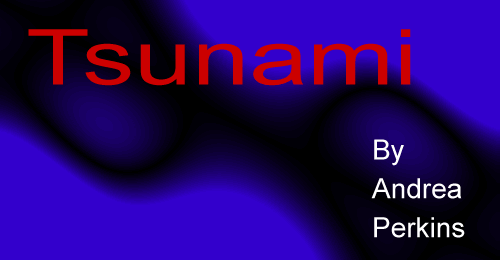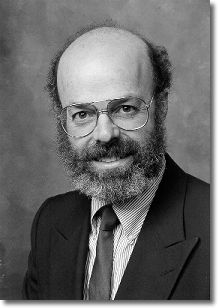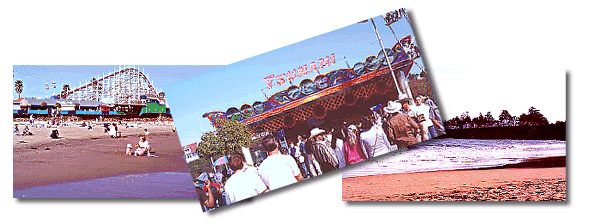
Just another sunny Saturday afternoon at the Santa Cruz Boardwalk. Small hands sticky with cotton candy grip tickets for the vintage carousel. A young man throws a dart through the center of a balloon (pop!) and wins a stuffed blue poodle. Girls in bikinis play Frisbee on the beach, where driftwood has been arranged into circles and clever lean-tos. Nearby, on the pier, people sip wine and listen to a live salsa band. Seals sleep on the rafters beneath, smiling in the late afternoon glow, the very picture of tranquility. Here all is peaceful. All is serene. And no one is worrying about the 100-foot-high wave that could come barreling out of nowhere at 400 miles per hour at any minute.
"It can happen here," says Richard Eisner, referring to tsunamis.
Most Californians are sensitive to their vulnerability to earthquakes -- and even somewhat nonchalant about it. But few are concerned with, or even aware of, the potential hazards of tsunamis. "The threat is very real," emphasizes Eisner, coastal regional administrator at the governor's Office of Emergency Services for northern California. "It has occurred in the past. The difficulty we have is that tsunamis are so infrequent that we can't estimate probability of loss."
According to statistics posted by the Federal Emergency Management Agency (FEMA) since 1945, tsunamis have killed more people than earthquakes . So what exactly is a tsunami? It's a series of waves generated by an "impulsive disturbance," i.e. undersea earthquakes, landslides, volcanic eruptions or even meteorites. Most of the time, however, earthquakes are to blame. Unlike a wind wave, which stays near the surface, a tsunami wave is a column of water that extends from the surface to the bottom of the ocean. Over the last 80 years, typical peak wave heights have been between 21 and 45 feet at the shoreline. A few have reached heights surpassing 100 feet.

Unlike earthquakes, tsunamis are a phenomenon that researchers are just beginning to understand. For centuries, they were referred to as "tidal waves" -- a misnomer, since "tidal" connotes tides, which are connected to the gravitational pull of the moon. The conventional thinking on what causes a tsunami has changed drastically in the last 20 years.
"We used to think that you only got one with a subduction earthquake, which is where the sea bed either lifts or drops," says Eisner. "But recently, we've seen tsunamis caused by very minor earthquakes that trigger landslides. We are also seeing tsunamis caused by strike-slip earthquakes, like one you would have on the San Andreas fault. ... We're learning a lot more, and it's not reassuring. We're learning that we're at greater risk then we thought."
A tsunami can reach speeds of 700 kilometers per hour in the deep ocean, losing virtually no energy in its passage towards land. As the waves enter shallow water, they rise. It's impossible to tell how high they will be until they hit the shore, which they do with little or no warning, causing from moderate to extreme destruction, depending on their size. The Japanese word "tsunami" literally means "harbor wave," because they can speed unnoticed across the ocean, then arise suddenly in shallow harbors.
In recorded history, tsunamis have killed from hundreds to tens of thousands of people, sometimes in less than 30 seconds. The Papua New Guinea tsunami of 1998 killed more than 2,200 villagers. A tsunami in the Sunda Straits of Indonesia in 1883 killed more than 30,000. The result of a nearby volcano, these waves were as high as a 12-story building.
While the Pacific Ocean is prime tsunami territory, researchers had long believed that the U.S. coast was relatively safe from the threat of serious devastation. New evidence now suggests that a major tsunami may strike the West Coast every 300 to 500 years. Current thinking is that the Cascadia subduction zone, an area off the Pacific Northwest coast where a crustal plate carrying part of the ocean dives under the continent, last had an earthquake in the 1700s, which generated a giant and deadly tsunami.
"We guess it was about 30 meters high," says Eisner, explaining how marine sand deposits have been found in Oregon, evidence of this great event. "All along the Oregon coast, you see these swamps full of dead trees," he continues, "and these trees have been core-dated. They all died in the 1700s, correlating with the dates of the sand deposits, which were carried by powerful waves up onto the coastal bluffs."
The Cascadia subduction zone is nearing the end of its seismic cycle. With recurrence of this phenomenon projected at 300 to 500 years, we're about to become due for another one. It is estimated that about 300,000 people live or work in California's coastal regions, and at least as many tourists visit them every year.
"There is a great concern," says Eisner quietly, "that if that event does occur, there would be virtually no warning. All the coastal counties of California would be at risk."
It won't be the first time California has seen "the unsurfable wave." In the state's short recorded history (starting with mission records from the early 1800s), 14 tsunamis have struck the California coast. Six of them were destructive. The worst tsunami that we know of was the result of the 1964 Alaskan (Good Friday) earthquake and caused 12 deaths and at least $17 million in damages in northern California. In Crescent City, buildings were lifted and moved by the force of the water. The 1960 Chilean quake caused minor damage in San Francisco Bay. The 1992 Cape Mendocino earthquake was another wake-up call. Although not damaging, this one-foot tsunami, which reached Humboldt Bay 20 minutes after the shaking, proved that locally generated tsunamis can reach the coastline quickly, giving authorities no time to issue a warning. If there had been a bigger earthquake, it would have been a bigger tsunami.
Luckily, something is being done to prepare for the worst. However, these new tsunami programs are still in the preliminary stages of data-gathering and analysis. If the wave comes tomorrow, there isn't much anyone can do. Since the 1964 quake, the Tsunami Warning Center in Palmer, Alaska, has been responsible for issuing warnings about potential tsunamis along the entire West Coast. It was only three years ago that Congress set aside $2.3 million for the National Tsunami Hazard Mitigation Program. A partnership between Alaska, California, Hawaii, Oregon and Washington, in league with NOAA, FEMA and the U.S. Geological Service, the program focuses on three activities.
"The first part of the national program," explains Eisner, "is improving the seismic network, so that the information from the Alaska and Hawaii warning centers gets dispersed more effectively.The second part involves ocean-going buoys. We now have three prototypes in the north Pacific and one off Monterey, that can measure a tsunami as it passes."
Once in operation, these buoys will be a big improvement on the current practice of inferring from an earthquake whether a tsunami has been generated and waiting for it to arrive. They will actually be able to determine information in real time about the wave as it passes in mid ocean.
"This is a huge advance in technology," continues Eisner, "that will enable us to better understand tsunamis and issue watches and warnings." Or cancel watches, so people aren't evacuated needlessly. Since the 1950s, a 75 percent false-alarm rate has prevailed. "Crying wolf" not only undermines the credibility of the warning system, but puts people at risk during the evacuation.
The third part of the program involves the production of inundation maps for the coasts of the five Pacific states. These maps will be used to develop evacuation planning. Surprisingly, these are the first maps of their kind. While similar inundation maps were developed in the 1970s by the U.S.G.S. and the Department of Housing and Urban Development for the coastal community, they were part of a national flood insurance program.
"There was in fact a regulatory factor to those maps," says Eisner, "in that if you lived in a tsunami inundation zone, you had to have flood insurance."
The national program will also focus on outreach. Until very recently, there has been no public education element for local governments when it comes to tsunamis. Funding from the national program is now allowing California to prepare guidance for local governments on how to develop public educational tools, as well as evacuation plans and construction codes that are suited for tsunami zones.
"We're doing some things because of the uncertainty," explains Eisner, "and we're being very cautious. We're trying to get information out to local governments and district coastal commissions, so they can better understand the threat and educate the public."
So far, San Mateo has been the leading county for tsunami response planning. Their warning and notification process, public educational videos and land use and development guides have been models that other counties at risk, such as Humboldt, are now following. The problem is that tsunamis are so infrequent that local governments have to make a decision about what, for them, is an acceptable level of risk.
"Is an event that occurs every 100 years, even though it may be horrendous, an acceptable level of risk if you have a good warning system and can evacuate people so that there's no life loss?" asks Eisner.
At the moment, the emphasis is on evacuation planning, not quantifying property damage. "If we decide to initiate mitigation to reduce exposure, it's going to take decades. Especially when we start considering more complex areas, such as the San Francisco Bay. We don't really know what will happen if a big wave hits it," he confesses. Conventional wisdom has always been that the Golden Gate is so narrow that it would cut down the incoming water flow. "But we don't really know that for sure," adds Eisner. "We would need to model a tsunami into the bay, which would be a major effort that we simply don't have the funding for right now."
There are many things that can't be quantified. If it came in on high tide, even a one- or two-meter wave can cause damage. At low tide, such a wave becomes irrelevant.
However, tsunami researchers all agree that destructive tsunamis are inevitable. While technology can be used to help prepare for these inevitabilities, it alone cannot save lives. Coastal inhabitants must take responsibility for their own safety by learning to recognize signs of a possible tsunami and familiarizing themselves with effective evacuation routes. For more information on preparing for a tsunami, visit www.fema.gov/library/tsunami.htm.
Meanwhile, sip your lemonade, build your sand castle and listen to the peaceful crashing of the waves. . .
